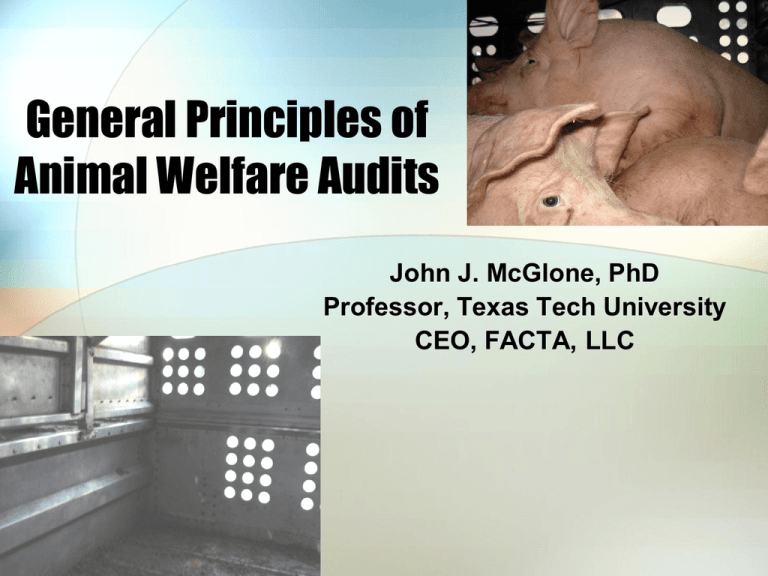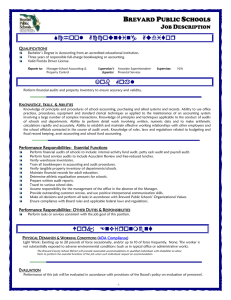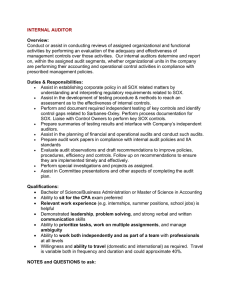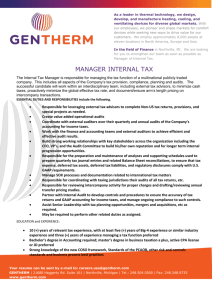General Principles of Animal Welfare Audits John J. McGlone, PhD
advertisement

General Principles of Animal Welfare Audits John J. McGlone, PhD Professor, Texas Tech University CEO, FACTA, LLC Outline • What is animal welfare? • What are the welfare issues at a processing plant? • Plant tactics to do well on audits • First, second and third-party audits • Qualifications of auditors • Sample size determination • Conduct of the audit • Reporting results • Ethics What is Animal Welfare? • A controversial topic for activists, scientists and for some consumers • What is the basis of defining AW? • • • • • Emotions? Anthropomorphism? Science? Objective data? Subjective data? What would ‘regular’ people think? What is Animal Welfare? • Welfare ranges from poor to adequate to good • Adequate welfare is the minimum standard What is Animal Welfare? Adequate welfare includes: • Free from pain • Free from distress including psychological distress • Basic needs met for: • • • • Space Temperature Feed & Water Health What is Animal Welfare? Adequate welfare does not include: • Access to entertainment/toy s or ‘fun’ • Excess eating or drinking • Drugs that make animals ‘feel’ good • Extraordinary comfort What are the issues at a plant? • Any event from arrival, unloading, resting, stun and exsanguination, including • DOA and nonambulatory animals • Adequate space • Access to water if resting • Lack of physical abuse moving animals • Facilities that do not injure animals • Proper stun and stick Plant tactics to do well on audits • Spread the word when the auditor arrives that the auditor is on site • Slow down the line speed • Change human behaviors to be less aggressive • Do not keep internal records to avoid ‘looking bad’ First, Second, Third Party Audits Consider processor and its customer • First party audit: Internal audit by processor • Second party audit: customer audit or processor may bring in a consultant/auditor to look at its process • Third party audit: Not the processor or the customer and not conflicted with either Qualifications of Auditors • They should be trained in quality audit techniques • They must have enough experience to use some professional judgment (ex., nipple waterers are not a sharpprotruding object) • Eventually, all AW auditors will be PAACO-certified Selecting a sample size • Start with the normal distribution of animals; mostly fine, some excessive (to the right on the graphs). • Some populations are variable (see blue line) and some are uniform (see red line). • The extreme values fall on one end of the curve (see arrow on blue line) • Those are ‘errors’ or problem values or noncompliant values based on the standards selected Selecting a sample size • The sample size needed is determined by the rate of ‘error’ in the product • The audit is attempting to find errors or out of compliance issues as a way of addressing if the minimum standards are met • The lower the error rate (or in our case, AW issues), the larger the sample size must be Graph shows sample size needed to find errors with a population of 1,000 items (or animals) (Sawyer, 1996) Sample size needed, number/1,000 Sample Size Calculation y = 228.2x -0.8772 R2 = 0.9804 1000 900 800 700 600 500 400 300 200 100 0 0 10 20 30 40 50 60 Rate of "problem" in % •Consider here a plant that processes 1,000 animals per hour •With a high error rate, fewer samples are needed •If the error rate is 1%, 275 animals must be observed •A sample of 100 animals can detect an error rate over 3% on average •A 0.1% (1/1,000) error rate means 950 must be observed Conduct of the Audit • Auditor must be professional at all times • Audit must be well documented using numbers if possible • Auditor must be non-intrusive • Auditor should be not visible to staff being audited if at all possible • A person in a white lab coat carrying a clipboard changes human behaviors Reporting results • Results are reported to the person paying for the audit, unless other arrangements have been made ahead of time • Results must always be confidential • Third party audit results should be shared with processor and customer • After the audit, if all agree, the results may be shared with others Ethics • A quality audit can only be effective if all three parties are honest and ethical • Auditors should refrain from accepting gifts or food from either party unless it is socially negative to refuse (this should be rare) • All parties should avoid telling others the outcome of audits unless all parties agree The End







